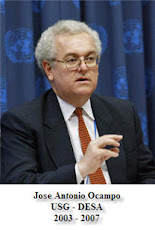
The threat of climate change is now overwhelming the dialogue on forest policy. Forests, like other ecosystems, will be affected by temperature increase. But the dimension that is receiving much more attention is their role as a store for carbon. Forests hold more carbon than the atmosphere, and the interchange of carbon between the two is a major element in the climate debate. Forest loss accounted for 20 per cent of carbon emissions, according to the IPCC (Intergovernmental Panel on Climate Change), and reducing this is seen as a low-cost way of mitigating the threat of climate change.
These climate concerns will lead to greatly-expanded international funding for forestry. It is under discussion in UNFCCC (United Nations Framework Convention on Climate Change) under the heading Reducing Emissions from Deforestation and Degradation (REDD), and the World Bank has already established two windows for climate-related forestry projects.
We see the beginnings of this shift in the NAPCC (National Action Plan on Climate Change) mission on Green India. The Ministry of Environment and Forests is getting into the act and according to a recent study put out by it, the carbon sequestered in India’s forests rose by about 138 mt of CO2 equivalent per year between 1995 and 2005, and “neutralised” about 9 per cent of our year 2000 level of CO2 emissions.
A measure of caution is required in shifting the focus of forestry just to carbon sequestration. It could be as distorting as the earlier focus on production forestry. Consider the experience of India with “scientific forestry” set up after the British brought in three German foresters to establish the forest department and the forest institute in Dehra Dun. Sustainable working plans were prepared for the forests which were brought under government control and removals were calibrated to match annual increments in forest stock. But this did not prevent large-scale forest loss with surviving dense forests found only in inaccessible areas.
An even bigger distortion was the alienation of forest communities that were treated as interlopers. Moreover, since sustainability was defined in terms of maintenance of growing stock, there was also a monomaniacal obsession with replanting quicker-growing species with little regard to other ecological consequences. Thus, the replacement of broad-leaved oaks with pines in the Himalayas altered the water retention capacity of forests for the worse.
Forests are part of a wider ecosystem and deliver services that are far more than forest products even from the perspective of climate change. For instance, forests play a role in hydrology and could be an important element in coping with the impact of climate change on precipitation and river flows.
Forests are not empty land. There are 173,000 villages in or near forests. For people in these villages, forests are a source of livelihood and cultural value. For them, diversity matters as they have a use for many species, some for food, some for liquor, some as host plants for silk worms and so on. Their goal is a sustainable livelihood based on forest resources, not growing stock or carbon sequestration.
Over the past few decades, we have seen a healthy shift in forest policy with a stronger emphasis on conservation, including a ban on logging in many places, on biodiversity and wildlife protection, and on community rights with the spread of joint forest management. My fear is that the large sums of international money that will become available as part of the climate change mitigation effort will undo many of these gains.
The focus on growing stock led to the destruction of biodiversity as fast-growing and commercially-attractive species replaced native trees. Will the emphasis on the role of forests in climate change lead to an excessive focus on species that are most efficient in carbon capture? Will this be sufficiently restrained by pious language about sustainable development?
The promotion of “scientific” forestry led to the shift of control to large forest departments and the marginalisation of forest communities. It also opened up forests to large companies. Will this also happen with carbon sequestration forestry projects as international donors may find it easier to work with large public and private organisations rather than with small local communities?
The major difficulty in forest development has always been the fact that those who bear the cost of forest protection and management cannot monetise the value of the preserved forest to others. The ecosystem services of forests in the form of water regulation, biodiversity, landscape quality and so on are not readily marketable. In this situation, foresters are tempted by the smell of money for at least one ecosystem service, that of carbon sequestration.
Carbon funding for forestry is going to come. There is no point in fighting this. What we have to do is to make this one-dimensional funding objective consistent with other goals for forestry policy and with decentralisation and empowerment of forest communities. Hence I would propose that carbon funding for forestry should include a biodiversity bonus, a water regulation bonus, and a community rights bonus. Thus, all such funding, whether it is channelled through a carbon credit mechanism or through straightforward public funding, should give more for carbon sequestration if this is done in a manner that conserves biodiversity and protects wildlife, that maintains or improves the water regulation properties of the forest and that shares management responsibility and returns with local forest communities.
Calculating these bonuses does pose measurement problems and will require a great deal of creativity. But even the calculation of the quantity of carbon sequestered by different types of species in varying growing conditions poses similar measurement problems. A bigger issue is the willingness of carbon credit buyers to pay the bonuses. If they are commercial entities buying these as offsets for their own obligations, then they may well refuse to pay extra for goals that are of no monetary value to them. But if the funding is from public sources, as proposed by some potential donors, then this is a less serious problem. Maybe this is a good reason for keeping carbon funding for forestry outside the commercial framework of carbon credit markets.
One final thought — what happens to our forests will depend not just on the forest policy but also on the way in which mining, energy, agriculture and human settlement policies contain the pressure on forest lands, and carbon funding for forestry will have little impact on these other areas of the policy.






















No comments:
Post a Comment